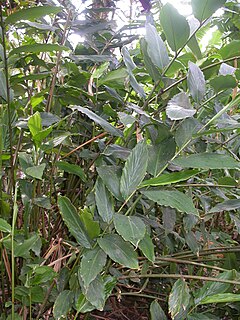
Crotalaria is a genus of flowering plants in the legume family Fabaceae commonly known as rattlepods. The genus includes about 500 species of herbaceous plants and shrubs. Africa is the continent with the majority of Crotalaria species, which are mainly found in damp grassland, especially in floodplains, depressions and along edges of swamps and rivers, but also in deciduous bush land, roadsides and fields. Some species of Crotalaria are grown as ornamentals. The common name rattlepod or rattlebox is derived from the fact that the seeds become loose in the pod as they mature, and rattle when the pod is shaken. The name derives from the Ancient Greek κρόταλον, meaning "castanet", and is the same root as the name for the rattlesnakes (Crotalus).

Parochetus communis, known in English as shamrock pea or blue oxalis, is a species of legume, and the only species in the genus Parochetus and in the subtribe Parochetinae. It is a low-growing plant with blue papilionaceous flowers and clover-like leaves. It is found in the mountains of Asia and tropical Africa, and has been introduced to New Zealand.
Erythrina schliebenii is a species of legume in the family Fabaceae. It is found only in Tanzania. The species is named for German collector and botanist Hans-Joachim Schlieben.

Aframomum zambesiacum is a species in the ginger family, Zingiberaceae. Its common name is nangawo. It is native to Kimalila, part of the southern highlands in Tanzania. A. zambesiacum grows in upland and secondary forests, often near water, between altitudes of 1,450–2,050 m (4,760–6,730 ft).
Acritochaete is a genus of African plants in the grass family.
Chaetopoa is a genus of African plants in the grass family, found only in Tanzania.
Chlorocalymma is a genus of Tanzanian plants in the grass family. The only known species is Chlorocalymma cryptacanthum, native to the Iringa Region of central Tanzania.
Adenodolichos is a genus of shrubs in the legume family Fabaceae, native to tropical Africa.
Fuerstia is a genus of plants in the family Lamiaceae, first described in 1929. It is native to eastern and southern Africa.
- Fuerstia adpressaA.J.Paton - Angola
- Fuerstia africanaT.C.E.Fr. - East Africa
- Fuerstia angustifoliaG.Taylor - Tanzania, Angola, Malawi, Zambia
- Fuerstia bartsioides(Baker) G.Taylor - South Sudan
- Fuerstia dendrothrixA.J.Paton - Somalia
- Fuerstia raraG.Taylor - Angola
- Fuerstia rigida(Benth.) A.J.Paton - Angola
- Fuerstia ternataA.J.Paton - Tanzania
- Fuerstia welwitschiiG.Taylor - Angola

The blue-leaved mistletoe is a species of perennial, parasitic plant in the family Loranthaceae, which is native to the southeastern Afrotropics.
Agelanthus kayseri is a species of hemiparasitic plant in the family Loranthaceae, which is native to Kenya, Tanzania and Somalia.
Agelanthus keilii is a species of hemiparasitic plant in the family Loranthaceae, which is native to Rwanda, Tanzania and Burundi.
Agelanthus igneus is a species of hemiparasitic plant in the family Loranthaceae, which is native to Mozambique and Tanzania.
Agelanthus microphyllus is a species of hemiparasitic plant in the family Loranthaceae, which is native to Ethiopia, Kenya and Tanzania.
Agelanthus uhehensis is a species of hemiparasitic plant in the family Loranthaceae, which is native to Tanzania.
Agelanthus validus is a species of hemiparasitic plant in the family Loranthaceae, which is found in the Usambara Mountains, Tanzania
Agelanthus longipes is a species of hemiparasitic plant in the family Loranthaceae, which is found in the Tanzania, Mozambique and Kenya.
Agelanthus pennatulus is a species of hemiparasitic plant in the family Loranthaceae, which is found in Tanzania, and Kenya.
Agelanthus nyasicus is a species of hemiparasitic plant in the family Loranthaceae, which is native to Botswana, Malawi, Mozambique, Tanzania, Zambia, Zaïre and Zimbabwe.
Adenodolichos kaessneri is a plant in the legume family Fabaceae, native to central Africa.



